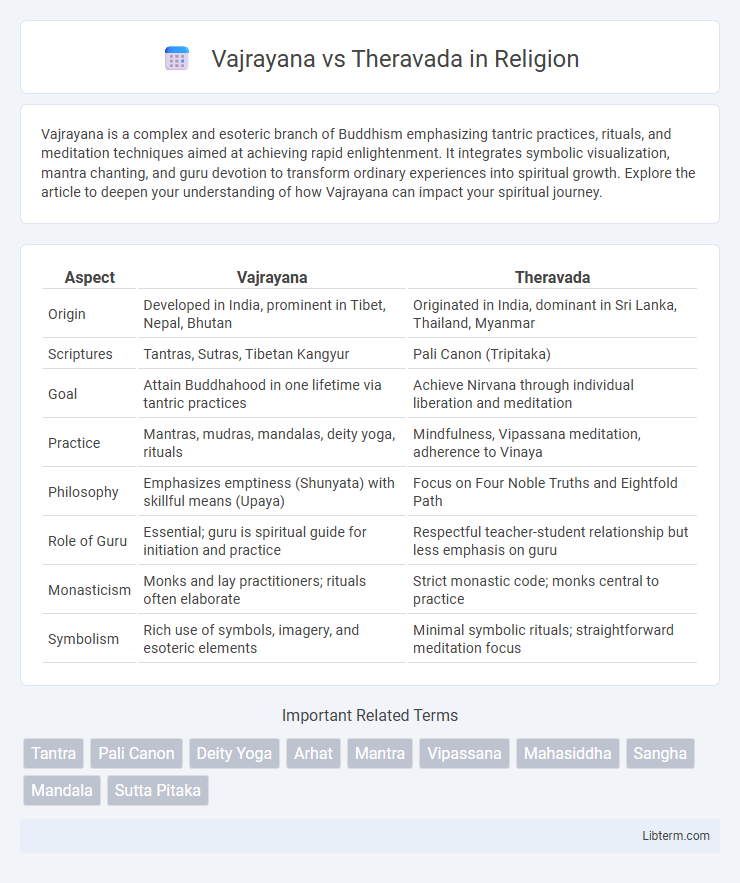Vajrayana is a complex and esoteric branch of Buddhism emphasizing tantric practices, rituals, and meditation techniques aimed at achieving rapid enlightenment. It integrates symbolic visualization, mantra chanting, and guru devotion to transform ordinary experiences into spiritual growth. Explore the article to deepen your understanding of how Vajrayana can impact your spiritual journey.
Table of Comparison
| Aspect | Vajrayana | Theravada |
|---|---|---|
| Origin | Developed in India, prominent in Tibet, Nepal, Bhutan | Originated in India, dominant in Sri Lanka, Thailand, Myanmar |
| Scriptures | Tantras, Sutras, Tibetan Kangyur | Pali Canon (Tripitaka) |
| Goal | Attain Buddhahood in one lifetime via tantric practices | Achieve Nirvana through individual liberation and meditation |
| Practice | Mantras, mudras, mandalas, deity yoga, rituals | Mindfulness, Vipassana meditation, adherence to Vinaya |
| Philosophy | Emphasizes emptiness (Shunyata) with skillful means (Upaya) | Focus on Four Noble Truths and Eightfold Path |
| Role of Guru | Essential; guru is spiritual guide for initiation and practice | Respectful teacher-student relationship but less emphasis on guru |
| Monasticism | Monks and lay practitioners; rituals often elaborate | Strict monastic code; monks central to practice |
| Symbolism | Rich use of symbols, imagery, and esoteric elements | Minimal symbolic rituals; straightforward meditation focus |
Introduction to Vajrayana and Theravada
Vajrayana Buddhism emphasizes esoteric rituals, tantric practices, and the use of mantras and mandalas to achieve enlightenment rapidly, often within a single lifetime. Theravada Buddhism, known as the "Doctrine of the Elders," focuses on the original teachings of the Buddha with a strong emphasis on meditation, ethical conduct, and the pursuit of individual liberation through the Noble Eightfold Path. Both traditions share core Buddhist principles but differ significantly in practice, theology, and approach to enlightenment.
Historical Origins and Development
Vajrayana Buddhism originated in India around the 6th to 7th centuries CE as an esoteric and tantric extension of Mahayana Buddhism, emphasizing ritual, meditation, and symbolism for accelerated enlightenment. Theravada Buddhism traces its roots to the earliest Buddhist teachings preserved in the Pali Canon, emerging around the 3rd century BCE and becoming predominant in Sri Lanka and Southeast Asia. While Theravada centers on monastic discipline and scriptural study based on the original Buddha's teachings, Vajrayana incorporates tantric practices and complex deity visualizations, reflecting its later historical development and synthesis of indigenous Indian traditions.
Core Philosophical Differences
Vajrayana emphasizes esoteric practices, tantra, and the concept of the Buddha nature inherent in all beings, focusing on rapid enlightenment through ritual, meditation, and mantra. Theravada centers on the Pali Canon teachings, prioritizing the Four Noble Truths, the Eightfold Path, and gradual liberation through personal insight and ethical conduct. Core philosophical differences hinge on Vajrayana's use of symbolism and tantra as skillful means contrasted with Theravada's strict adherence to early Buddhist scriptures and monastic discipline.
Textual Canons and Sacred Literature
Vajrayana Buddhism incorporates the Tibetan Buddhist Kangyur and Tengyur collections, encompassing a vast array of tantric texts, commentaries, and ritual manuals that emphasize esoteric practices. Theravada Buddhism relies primarily on the Pali Canon (Tipitaka), consisting of the Vinaya Pitaka, Sutta Pitaka, and Abhidhamma Pitaka, which form the doctrinal foundation of early Buddhist teachings. Vajrayana's sacred literature extends beyond the Pali Canon to include tantras and Dzogchen texts, reflecting a complex synthesis of scriptural authority and mystical experience.
Rituals and Meditation Practices
Vajrayana Buddhism emphasizes elaborate rituals, including deity visualization, mantra chanting, and complex mandala offerings, designed to accelerate spiritual awakening through esoteric practices. Theravada Buddhism focuses on Vipassana meditation, emphasizing mindfulness and insight into the impermanence of phenomena, with simpler rituals centered on moral precepts and monastic discipline. Both traditions use meditation as a core practice, but Vajrayana incorporates tantric techniques to transform the practitioner's perception at a faster pace than the Theravada gradual approach.
Monastic Structure and Lay Participation
Vajrayana Buddhism features a flexible monastic structure with both monks and lay practitioners actively engaging in tantric rituals and esoteric practices, emphasizing guru devotion and the integration of meditation with daily life. Theravada Buddhism maintains a strict monastic hierarchy centered on the Vinaya code, where fully ordained monks lead spiritual teachings while lay followers support through almsgiving and merit-making without entering monastic rituals. The distinction highlights Vajrayana's inclusion of advanced tantric methods accessible to disciplined laypeople, contrasting with Theravada's emphasis on monastic renunciation and community support.
Deity Worship vs. Non-theistic Focus
Vajrayana Buddhism emphasizes deity worship, incorporating complex rituals, mantras, and visualizations to engage with enlightened beings such as Bodhisattvas and Buddhas. In contrast, Theravada Buddhism adopts a non-theistic focus, centering on the historical Buddha's teachings and personal meditation without invoking divine entities. This fundamental difference shapes Vajrayana's ritualistic practices and Theravada's emphasis on individual enlightenment through mindfulness and ethical conduct.
Paths to Enlightenment: Methods and Goals
Vajrayana Buddhism employs esoteric rituals, mantra chanting, and visualization techniques to accelerate the path to enlightenment, emphasizing the transformation of ordinary experiences into spiritual wisdom. Theravada Buddhism focuses on the gradual development of insight through meditation, ethical conduct, and wisdom, aiming for the attainment of Nirvana and liberation from the cycle of rebirth. Both paths share the ultimate goal of enlightenment but differ significantly in their methods and spiritual practices.
Influence and Geographic Distribution
Vajrayana Buddhism primarily influences regions such as Tibet, Bhutan, Nepal, and parts of Mongolia, emphasizing esoteric rituals and tantric practices. Theravada Buddhism dominates Southeast Asian countries including Sri Lanka, Thailand, Myanmar, Laos, and Cambodia, focusing on the Pali Canon and monastic discipline. Both traditions shape their cultural landscapes significantly, with Vajrayana integrating indigenous beliefs and Theravada reinforcing Theravada's early Buddhist teachings.
Contemporary Relevance and Global Impact
Vajrayana Buddhism influences contemporary culture through its rich symbolism and meditative practices, attracting global practitioners interested in esoteric rituals and Tibetan traditions. Theravada maintains a strong presence in Southeast Asia, emphasizing mindfulness and monastic discipline, which has contributed to the global mindfulness movement and academic studies on early Buddhist teachings. Both traditions shape global perceptions of Buddhism, fostering cross-cultural exchanges and spiritual diversity.
Vajrayana Infographic

 libterm.com
libterm.com